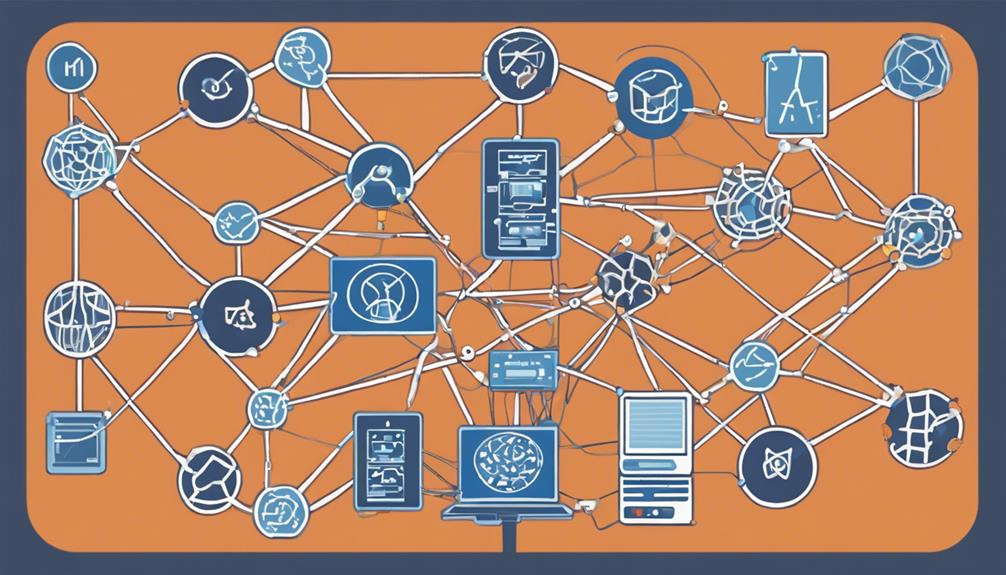You might be curious about which tools are used for web data mining. From Python and R to Apache Hadoop and RapidMiner, each tool serves a specific purpose in extracting and analyzing valuable insights from web data. Understanding the intricacies of these tools can significantly impact the efficiency and accuracy of your data mining endeavors. Keep on exploring the world of web data mining tools to discover how they can streamline your data analysis processes and unlock hidden patterns within the vast realm of web data.
Python for Web Data Mining
When it comes to web data mining, Python stands out as a powerful tool for extracting and analyzing information from websites efficiently. Python offers a wide array of libraries and frameworks that make it a top choice for web data mining tasks. For data visualization techniques, Python provides libraries like Matplotlib and Seaborn, allowing you to create visually appealing graphs and charts to represent mined data effectively. These visualization tools are vital for gaining insights into the patterns and trends present in the extracted data.
Moreover, Python’s compatibility with various machine learning algorithms makes it a versatile option for web data mining projects. Libraries such as Scikit-learn and TensorFlow enable you to implement complex machine learning models to analyze and predict patterns in web data efficiently. By leveraging Python’s machine learning capabilities, you can enhance the accuracy and efficiency of your web data mining processes, ultimately leading to more informed decision-making based on the extracted insights.
R for Web Data Mining
Python’s dominance in web data mining is undeniable, but when it comes to leveraging another robust language for this task, R emerges as a formidable contender. R is a powerful tool that offers a wide range of capabilities for web data mining, particularly in the areas of data visualization and implementing machine learning algorithms. Here are some key features of using R for web data mining:
- Rich Data Visualization: R provides a plethora of libraries like ggplot2 and plotly that enable you to create interactive and visually appealing plots to analyze and present your web-mined data effectively.
- Extensive Machine Learning Algorithms: With packages such as caret and randomForest, R allows you to develop and deploy various machine learning models for predictive analysis and pattern recognition on web data.
- Statistical Analysis: R’s strong statistical capabilities make it suitable for performing in-depth statistical analysis on the web-mined data, helping you derive meaningful insights and make informed decisions.
- Integration with Web Scraping Tools: R can seamlessly integrate with web scraping tools like rvest, making it easier to gather and analyze data from websites efficiently.
SQL for Web Data Mining
SQL serves as a fundamental tool for web data mining, offering a structured query language that facilitates efficient retrieval, manipulation, and analysis of data from web sources. When comparing SQL to NoSQL for web data mining, SQL is advantageous due to its ability to handle complex queries and relational data structures effectively. NoSQL databases are more suitable for unstructured data and scalability but lack the robust querying capabilities of SQL.
To optimize SQL queries for web data mining, it is essential to follow best practices. This includes avoiding unnecessary joins, using indexes appropriately to speed up data retrieval, and optimizing the query structure for performance. Additionally, utilizing functions like GROUP BY, HAVING, and ORDER BY can help organize and analyze the extracted data efficiently. It is crucial to write queries that are concise, well-structured, and tailored to the specific data mining objectives to enhance the overall effectiveness of the web data mining process.
Apache Hadoop for Web Data Mining
Apache Hadoop serves as a powerful framework for web data mining, offering a distributed storage and processing solution that can handle vast amounts of data efficiently. When it comes to big data processing using Apache Hadoop, here’s why it stands out:
- Scalability: Apache Hadoop allows you to scale your data mining operations seamlessly by adding more nodes to the cluster as your data grows, ensuring you can handle massive datasets effectively.
- Efficiency: The distributed nature of Apache Hadoop enables parallel processing of data, significantly improving the speed and efficiency of web data mining tasks.
- Fault-tolerance: Hadoop’s fault-tolerant architecture ensures that even if a node fails during processing, the system continues to function without losing any data or compromising the mining process.
- Cost-effectiveness: By running on commodity hardware, Apache Hadoop provides a cost-effective solution for organizations looking to perform large-scale web data mining operations without investing in expensive infrastructure.
RapidMiner and KNIME for Web Data Mining
When considering tools for web data mining, two prominent options to explore are RapidMiner and KNIME. RapidMiner is a powerful tool that offers a user-friendly interface for data preparation, machine learning, and data visualization techniques. It provides a wide range of machine learning algorithms, making it suitable for both beginners and advanced users in the field of data mining.
On the other hand, KNIME is an open-source platform that allows for visual programming and integration of various data sources. It also offers a rich set of data visualization techniques and supports a diverse range of machine learning algorithms, enabling users to build complex data mining workflows efficiently.
Both RapidMiner and KNIME excel in providing a platform for data preprocessing, modeling, evaluation, and deployment of machine learning models. Their intuitive interfaces and extensive libraries make them valuable tools for web data mining tasks that require robust data processing and analysis capabilities.
Frequently Asked Questions
What Are the Common Challenges Faced During Web Data Mining?
During web data mining, you may encounter challenges with data accuracy, data quality, data privacy, and data security. Ensuring these aspects are addressed diligently can lead to more reliable and secure data analysis outcomes.
How Can Web Data Mining Benefit Businesses?
Utilize web data mining to gain valuable customer insights for targeted marketing strategies. Analyze competitor data to refine your market positioning. By employing these techniques, businesses can boost efficiency, increase competitiveness, and drive strategic decision-making for sustainable growth.
Are There Any Ethical Considerations in Web Data Mining?
When engaging in web data mining, ethical implications must be considered. Data privacy is paramount. Ensure transparency, consent, and secure handling of information. Uphold ethical standards to build trust with users and avoid potential legal consequences.
What Are the Key Differences Between Web Scraping and Web Data Mining?
When comparing web scraping and web data mining, you’ll notice key differences. Web scraping focuses on extracting specific data from websites, while data mining involves analyzing and extracting patterns and insights using various data extraction techniques.
How Can Machine Learning Be Integrated Into Web Data Mining Processes?
To integrate machine learning into web data mining, explore various integration methods like feature selection and model ensembling. Employ predictive modeling techniques such as decision trees and neural networks to enhance data analysis and extraction for more accurate insights.



